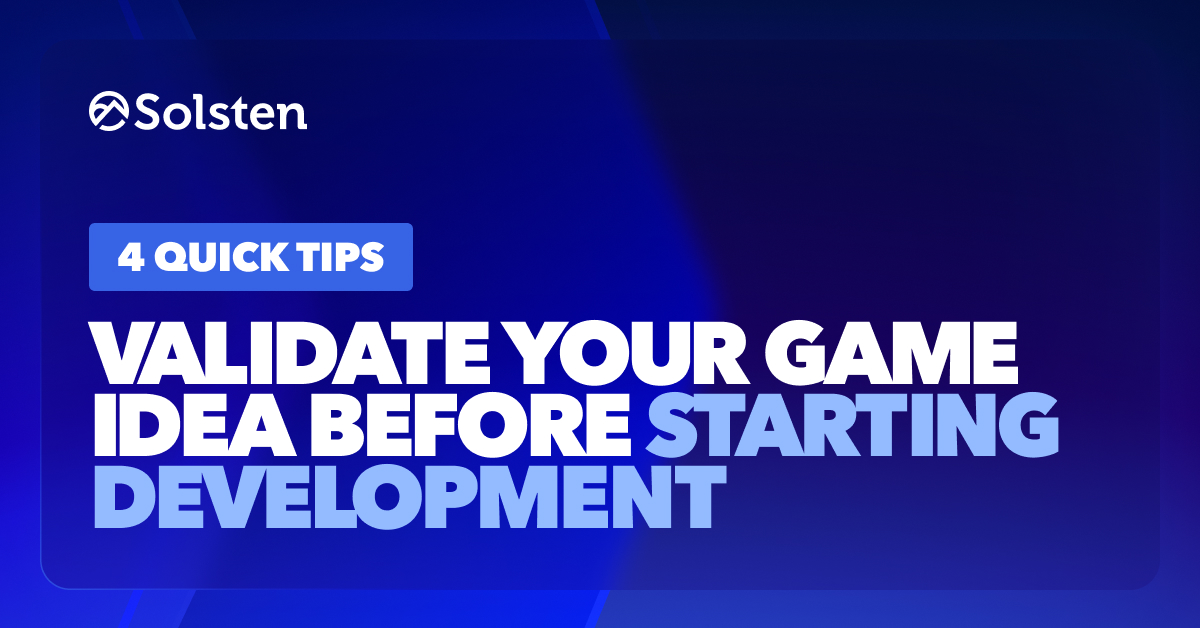There’s an old saying in carpentry: measure twice, and cut once. What this means is that when you’re building something, you want to be as accurate as possible. Otherwise, you have to hack things together when they don’t fit correctly, or buy more materials when you need to start from scratch.
Even the most skilled carpenters would never cut without measuring. Yet in the early stages video game development, this is often the prevailing mindset. Measurement is something that comes much later, once something has already been built.
The truth is that both data and expertise can work together in the early stages of game development. With the amount of blood, sweat, tears, years, and money that goes into developing a new video game, it’s important to do everything you can to test your game concept before starting development — to measure before you cut.
While one of those measurements should certainly be the domain expertise of a creative team, data can provide the second measurement. It can provide the assurance that a concept will evolve into a thriving game.
With this in mind, teams can adopt several approaches to concept testing games before starting development. Let’s look at four of the most effective ways we’ve seen creative teams tackle this process.
Want to test your concept instantly? Elaris provides immediate access to audience psychology for any game genre or demographic. Try it free.
1. Leverage Audience Intelligence
The number one reason that games fail is that they fail to find their audience. With tools like Elaris, developers can now align and refine every aspect of their game with the motivations and preferences of their ideal target audience before writing a single line of code.
Instead of lengthy research processes, developers can simply ask questions like: “What motivates puzzle game players?” or “How do mobile strategy players differ from PC strategy players psychologically?” This allows developers to assess the potential market size and viability of their idea, see which features and themes will resonate with their audience, and predict key performance indicators like retention and LTV.
Using insights from Elaris, developers can optimize their game design and prioritize features that are most likely to drive engagement and retention. This not only saves time and resources but also increases the chances of launching a successful game that stands out in a competitive market.
Ultimately, Elaris helps mitigate the risk and uncertainty associated with bringing a new game to market, increasing the likelihood of creating games that resonate with players and achieve long-term success
Test your concept with psychological insights in minutes
Skip months of expensive research. Ask Elaris about your game concept’s target audience: “What psychological traits predict success in my genre?” or “What motivates high-spending players in similar games?” Get instant insights that validate your concept and inform design decisions.
Start testing your concept for free
2. Create Player Personas
Developing detailed player personas can help you see whether your game concept aligns with the preferences, motivations, and behaviors of your target audience. By understanding your ideal players on a deeper level, you can tailor your game concept to better meet their needs and expectations, increasing the likelihood of success.
Here’s how player personas can help with concept testing games:
Identify Your Target Audience
By examining the player personas that are most likely to be interested in a game concept, developers can gain a clear understanding of their target audience. This includes insights into their psychological traits, motivations, and gaming preferences. With this information, developers can assess whether there is a sufficient market for their game idea and determine if it aligns with the interests of their target audience.
Test Game Features and Themes With Your Target Audience
Player personas provide detailed information about what players in each persona group enjoy in games. This can help developers test their game ideas by comparing the planned features, mechanics, and themes against the preferences of their target personas. If there is a strong alignment between the game concept and the desires of the target personas, it indicates a higher likelihood of the game resonating with players.
See Potential Challenges and Opportunities
Player personas help developers identify potential challenges or gaps in their game idea. For example, if a key feature of the game does not align with the preferences of the target personas, it may need to be adjusted or reconsidered. Alternately, the personas may reveal untapped opportunities or features that could be added to the game to better cater to the target audience.
Compare to Successful Games and Competitors
Developers can use player personas to compare their game idea to successful games in the market that cater to similar personas. This can provide valuable insights into what works well for the target audience and help identify opportunities for differentiation. By understanding the player personas targeted by competitors, developers can also identify potential gaps in the market that their game could fill.
By creating player personas early in the development process, developers can validate their concept, identify potential challenges and opportunities, optimize their game design, and compare their idea to successful games and competitors.
Tools like Elaris make creating detailed psychological personas accessible to any developer. Simply ask: “What are the key personality types in battle royale games?” or “How do casual mobile gamers differ psychologically from hardcore gamers?” Get instant persona insights without expensive research.
Create Psychological Personas Instantly With Elaris
Instead of filling out static templates, get dynamic persona insights through conversation. Ask about any gaming audience’s psychology, motivations, and preferences. Start free and discover what drives your target players.
3. Conduct Market Research
Conducting market research is a critical step in validating your game idea because it provides valuable insights into the current gaming landscape, player preferences, and the potential demand for your concept. Market research can ensure that your game idea aligns with market trends and player expectations, maximizing the chances of success.
Here’s a closer look at why market research is so important and how to approach it:
Understand the Competitive Landscape
By analyzing existing games in your target genre, you can identify what works well, what players enjoy, and where there are gaps or opportunities for innovation. This information helps to validate whether your game idea offers something unique or complementary to the current market offerings.
Align With Player Preferences
Market research helps to define a target audience and understand their gaming preferences, motivations, and behaviors. By gathering data on player demographics, gaming habits, and spending patterns, you can validate whether your game idea aligns with the needs and expectations of your intended audience.
Modern tools like Elaris can accelerate this research by providing instant access to psychological insights about any gaming audience. Ask questions about player motivations, preferences, and behaviors to quickly understand market alignment without lengthy surveys.
Assess Market Trends and Potential Demand
Analyzing market trends, such as popular game genres, emerging technologies, and shifts in player behavior, helps you validate whether a game idea is well-positioned for current and future market demand. You can conduct surveys and focus groups to gauge player interest in your concept and gather feedback on specific features or elements.
Evaluate Monetization Potential
Economic viability is necessary for a game’s success. Market research helps to validate this aspect of a game idea by assessing the monetization strategies of similar games, analyzing player spending habits, and estimating the potential revenue streams for a concept. This information will determine whether your game idea is financially feasible and aligns with your studio’s business objectives.
4. Address Player Pain Points
Focusing on player frustrations and unmet needs is a smart way to differentiate your game idea from competitors. It allows you to identify gaps in the market and create a more targeted, compelling experience. By validating that your game idea solves real problems or fulfills unmet desires for players, you can increase the likelihood of creating a successful and memorable game that stands out in a crowded market.
Here’s a closer look at why addressing player frustrations and unmet needs is so important in the idea validation stage:
Find Market Gaps and Opportunities
By researching and analyzing player frustrations with existing games in your target genre or niche, you can uncover market gaps and opportunities for innovation. This helps you validate whether your game idea has the potential to fill a unique space in the market and attract players who are looking for something new and different.
Differentiate From Competitors
When you validate your game idea based on its ability to solve player frustrations or fulfill unmet needs, you naturally differentiate your game from competitors who may be overlooking these key areas. This unique selling proposition can help your game stand out in the market and establish a strong brand identity that sets you apart from the crowd.
Build Player Loyalty
By validating that your game idea addresses genuine player needs and frustrations, you lay the foundation for building long-term player loyalty and advocacy. When players feel that your game truly understands and caters to their specific desires and challenges, they are more likely to form a strong emotional connection with your game, recommend it to others, and look forward to future releases or updates.
By focusing on player frustrations and unmet needs in the idea validation stage, you can create a more differentiated, targeted, and compelling game concept that resonates with your target audience.
Create a More Player-Centric Design
Validating your game idea through the lens of player frustrations and unmet needs ensures that your design decisions are grounded in a deep understanding of your target audience. By prioritizing features, mechanics, and experiences that directly address player pain points, you can create a more player-centric game that resonates with your target audience and builds a stronger sense of engagement and satisfaction.
To create player-centric games, you need to understand your players. Lack of knowledge about the target audience can lead to missteps, while overconfidence based on limited assumptions can cause stagnation and player alienation.
Investing in robust games user research provides the necessary insights to navigate player preferences, unveil hidden challenges, and illuminate the path to a resonant and thriving gaming experience. Player research and resonance studies are an excellent way validate a game concept at any stage of development. Learn more from Bilge Coskun, a UX researcher who has been building successful player-centric experiences at leading studios like Ubisoft and Tactile Games before joining Solsten.
Transform Concept Validation From Months to Minutes
Stop guessing what players want. Start asking Elaris about your game’s target audience psychology and get instant insights that validate concepts, inform design decisions, and predict market potential.


